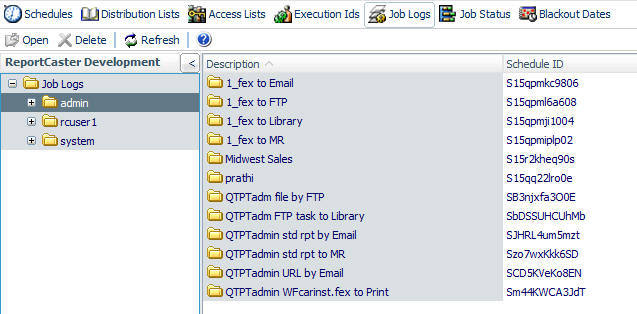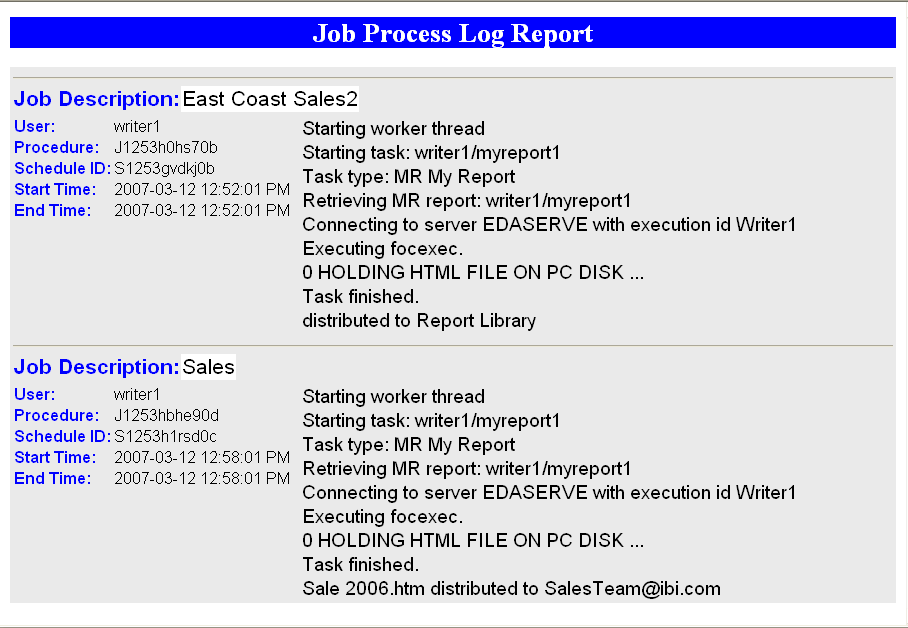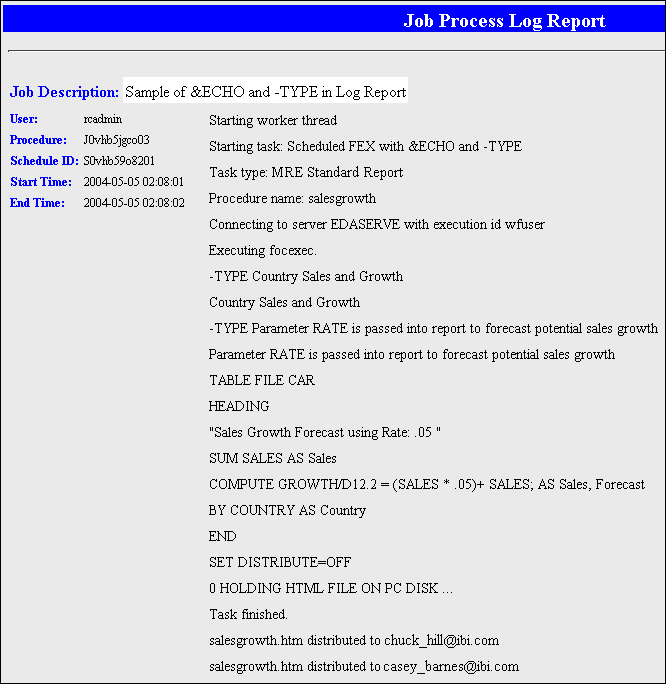
In this section: Reference: |
Log reports enable you to view information about a distributed job, such as whether or not the job executed successfully, when the scheduled output was distributed, in what format the distributed output was sent, and the method of distribution. Log reports are stylized HTML format and display in a separate browser window. You can search, print, or save the log report.
The log file accumulates information and can become difficult to navigate. Therefore, you should periodically purge log records in order to conserve space. For details on purging the log file, see Purging the Log File.
From the ReportCaster Development interface, access the schedule job logs by selecting the Job Logs tab. The following image is an example of the logs displayed in the Job Logs tab.

Select the job folder in the left pane to display the jobs that ran for that schedule. The following image shows the jobs available for the selected schedule.

The list in the right pane provides basic information about the job execution, including the Job Id, the time the job started running, the amount of time it took to complete the execution of the job, and the general status of the job. To view a full log report for a job, double-click the job of interest in the job list.
The log report displays information according to your specifications in a separate browser window. One log record is produced for each scheduled job run in the specified time frame. The following image provides an example of a typical log report.

If you chose to view log reports for multiple schedules, the Job Process Log Report contains a log record for each schedule you selected. The following image shows an example of a log report for multiple schedules.

The log report first lists the job description for the record, which is the unique description identifier that you specified when you created the schedule. Underneath the Job Description, the left column of the log report includes the following information:
In the second column, the log report specifies messages consisting of the following:
Values from &ECHO variables and –TYPE commands in WebFOCUS procedures appear in log reports. The &ECHO variable displays command lines as they execute in order to test and debug procedures. The -TYPE command enables you to comment and evaluate your code for informational and debugging purposes. For example, if the following procedure is scheduled using ReportCaster, it may produce a log report similar to the example that follows this procedure.
-SET &ECHO=ALL; -TYPE Country Sales and Growth -TYPE Parameter RATE is passed into report to forecast potential sales growth TABLE FILE CAR HEADING "Sales Growth Forecast using Rate: &RATE " SUM SALES AS 'Sales' COMPUTE GROWTH/D12.2 = (SALES * &RATE) + SALES; AS 'Sales, Forecast' BY COUNTRY AS 'Country' END
The following image shows an example of the log report.

When viewing a log report, be aware of the following considerations.
Task and Report Names:
The ReportCaster Log references Managed Reporting folders and FEXes by their names and not their descriptions.
E-mail Addresses:
ReportCaster cannot validate e-mail addresses since e-mail validation is performed by the mail server. The log report will include any e-mail addresses validated by the mail server and returned to ReportCaster.
Burst Reports:
Burst Value: value is not in the database.FILE filename SUCCESSFULLY DISTRIBUTED TO destination FOR burst value.
Unavailable Options:
When schedules with unavailable Task Types or distribution methods are not permitted to run, error notification is triggered. Information is included in the full and brief notifications and in the log report that your ReportCaster administrator or the owner of the schedule must change the unavailable Task Types or distribution methods in the schedule.
When schedules with unavailable Task Types or distribution methods are permitted to run, normal job execution occurs and a message appears in the log report indicating that your ReportCaster administrator is allowing existing schedules using the unavailable Task Types or distribution methods to run.
If you do not receive a log report because there is an insufficient amount of memory available, this may be because the report is too large or you have too many windows open. We recommend closing all windows and attempting to run the log report again. If you are still unsuccessful, rerun a schedule that successfully created a log report. If you are successful in running the log report, this confirms that the original log report that did not run was too large to be processed. Contact your ReportCaster administrator to help you troubleshoot this issue.
| WebFOCUS |